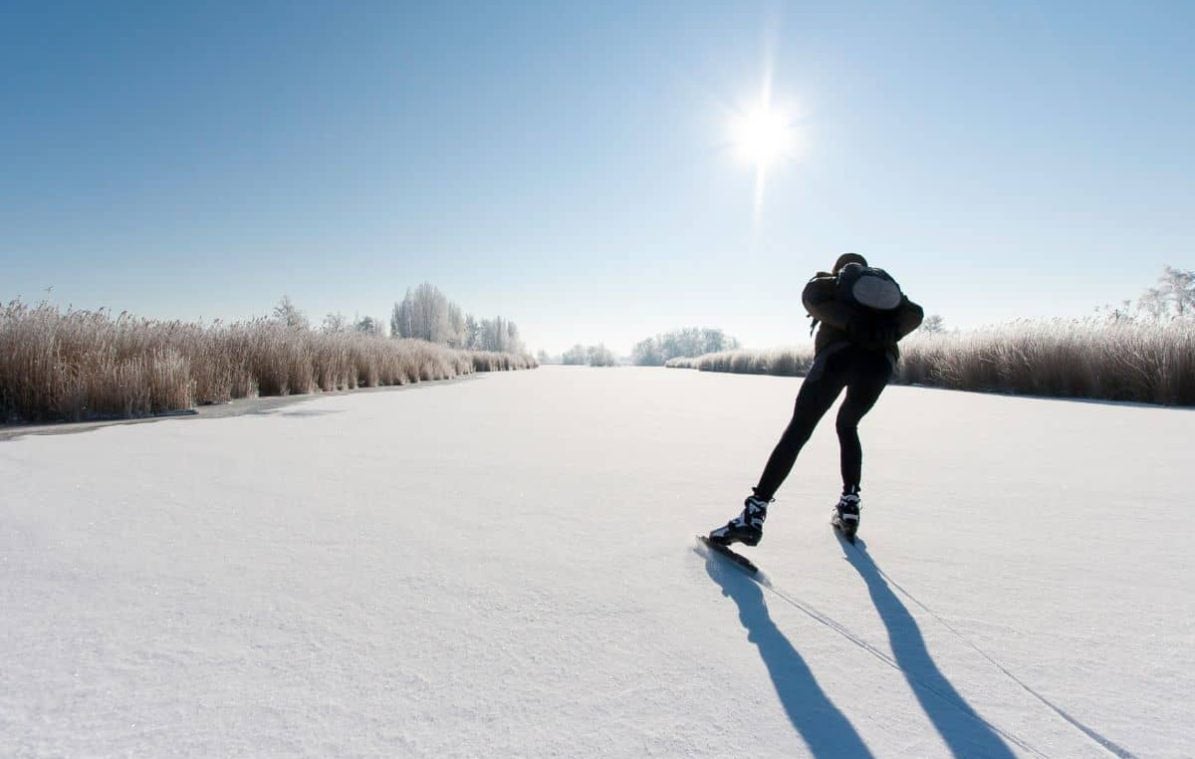The winter sport you should be doing: ice skating
 © foodspring
© foodspring
Need a good way to exercise during the winter? Ice skating has many benefits, both for your health and well-being, plus it’s super fun! If you’re a beginner, yes, you’re going to leave your butt on the track drop after drop. But it is worth learning. Discover how ice skating can help you achieve your fitness goals and improve various aspects of your physical and mental health.
Improve your muscle health: Ice skating strengthens all the muscles of the legs, especially the glutes and quadriceps, and the abdomen. Moving around the track will put your whole body into action. Ice skating is an aerobic exercise, like running or swimming. On skates, your heart pumps faster, improving your cardiovascular health. Plus, sliding on the ice is so much fun that you probably won’t even realize you’re exercising. Can you say the same about going for a run?
Improve your balance and coordination: When you strengthen your muscles your balance improves as well. When ice skating, you engage your muscles to keep you on your feet so you don’t take a big tumble. This way you not only tone your muscles, but also improve your body control and endurance. You’ll also be interested to know that according to Harvard Medical School, ice skating burns up to 200 calories per hour, making it a great way to lose or maintain weight, especially if you combine it with a healthy diet.
Improve your mental health: As you may well know, doing sports improves your mood by helping your body release endorphins, the hormones that give us that feeling of well-being after giving it all in a workout or finishing a race. Ice skating is no exception. By moving your body on the ice rink, your body releases these hormones, elevating your mood and helping to reduce anxiety and stress. In addition, learning to ice skate increases self-confidence and improves concentration. While you are thinking about not falling over, you will forget about everything else for a few moments. Above all, because there are always new movements to learn such as crossovers, skating backwards or turns. Going with friends to the track, or meeting new people during a class, is also an ideal way to relax and unwind after a day of putting up with your boss.
A bit of science: Although there isn’t much scientific literature dedicated specifically to ice skating, we can find some very interesting research on the sport. For example, in 2018, two Romanian scientists, Anca Ionescu and Dana Badau, conducted a study with 143 physical education and sports students. The study was conducted around the motor, mental and social benefits of this ice-based activity. The results highlighted the great benefits of skating on motor, mental and social skills in the opinion of the students who took part in the test. According to this study, students consider ice skating to be one of the activities through which a number of physical development parameters and fitness levels can be improved through the enhancement of motor skills. Furthermore, figure skating contributes to the formation of proactive behavior by improving the mental and social skills of participants.
Training on ice
Now that you’ve decided to get your skates on and hit the ice, let’s take a look at some workouts you can do on the blades that are just as, if not more, effective than what you can do in a gym or on a running track.
Skating for endurance: Try doing 10 laps of the track or two consecutive minutes at maximum speed, then slow down for 2 laps or thirty seconds. Repeat the whole exercise at least 4 or 5 times.
Skating to increase VO2 Max: VO2 Max is a measurement used to assess an athlete’s performance. Strictly speaking, it’s defined as the amount of oxygen consumed while performing a high-intensity sport activity and you can improve it by ice skating. A study published in the International Journal of Sports Medicine, showed that doing shuttle runs can increase VO2 Max. The procedure for this type of test consists of skating forward and backward over a distance of 45 m (stop and go) while following a rhythm set by a sound signal. In this way, the oxygen consumption at maximum speeds by hockey players during an intermittent test on ice was evaluated to see an improvement in the results for all test participants.
Skating to improve agility: Frequent ice skating is guaranteed to improve your agility. In addition to the difficulty of standing with the blades on the ice, you can add exercises to become more agile. Try skating on only one leg for one quarter of the track and switch to the other leg in the next quarter. Braking and direction changes are also very useful for improving agility.
Find out more about this topic at foodspring:
- 5 wonderful tricks for falling asleep immediately
- How to get a good night’s sleep: 8 tips to start the day off on the right foot
- Why is a good night’s sleep more important than the number of hours you sleep?
Sources for this article
We at foodspring use only high-quality sources, including peer-reviewed studies, to support the facts within our articles. Read our editorial policy to learn more about how we fact-check and keep our content accurate, reliable, and trustworthy.





























